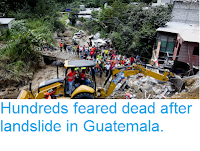Mount
Fuego a stratovolcano (cone shaped volcano made up of layers of ash and
lava) that forms part of La Horqueta volcanic complex in the southern
part of Guatemala underwent a major eruptive episode on Friday 24-Saturday 25 February 2017. The volcano began erupting at about 11.30 pm local time on Friday 24, and went on to produce a series of ash columns reaching 5 m high on the morning of Saturday 25, which prompted the Washington Volcanic Ash Advisory Center to issue a warning to aircraft in the area. The volcanic activity subsided during the afternoon, with a series of smaller ash columns. Three lava flows have been sighted on the volcano, the longest about 1600 m in length.
The approximate location of Mount Fuego. Google Maps.
Fuego
has been more-or-less constantly active at some level since records in
the area began (circa 1524). It forms part of La Horqueta volcanic
complex, which also includes the Acatenango volcano to the north, a
complex volcano with at least five separate vents, the complex siting on
the site of the ancient Meseta volcano, which is thought to have
collapsed following a major volcanic episode about 8500 years ago,
causing a debris flow that reached the sea, 50 km away.
The volcanoes of Guatemala, and Central America in general, are fed by the subduction of the Cocos Plate beneath the Caribbean Plate along the Middle American Trench, which runs roughly parallel to the southwest coast of the isthmus. As the Cocos Plate sinks into the Earth, it passes under Central America, which lies on the western margin of the Caribbean Plate. As this happens it is heated by the friction and the heat of the planet's interior, causing the sinking plate to partially melt. Some of the melted material then rises through the overlying Caribbean Plate as magma, fuelling the volcanoes of Central America.
See also...
Follow Sciency Thoughts on Facebook.







